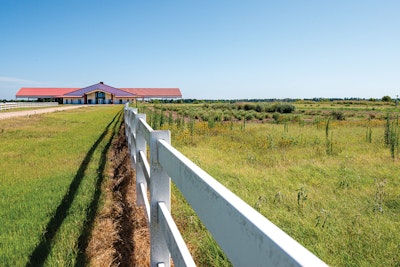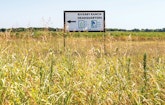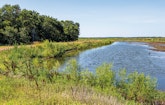
Construction Manager Daniel Kampfer, Director Matthew Stahman and ecologist Brandon Hall (from left) of Houston-based Resource Environmental Solutions stand at an improved low water crossing where an ineffective culvert was removed and native vegetation was added. The crossing is one of many smaller projects within the North Texas Municipal Water District’s massive Bois d’Arc Lake construction project northeast of Dallas. (Photography by Olivia Ogren-Hrejsa)
Interested in Infrastructure?
Get Infrastructure articles, news and videos right in your inbox! Sign up now.
Infrastructure + Get AlertsBuilding a dam is one thing. Building a forest is something else altogether. The North Texas Municipal Water District has done both.
The district, which services about 80 communities north and east of the Dallas metropolitan area, is completing an ambitious construction-restoration project. It not only created a critically needed water source for 2 million water users but is re-creating a forest on land that many years ago was converted to agricultural and ranching operations.
The Bois d’Arc Lake construction project northeast of Dallas is the first major reservoir built in Texas in three decades. The earthen dam structure itself is two miles long, rises 90 feet and will create a reservoir covering 26 square miles, or more than 16.6 acres.
The impounded water will be pumped 35 miles to the district’s new Leonard Water Treatment Plant. The plant initially will produce 70 million gallons per day of treated water but was designed to eventually treat 280 mgd, according to Galen Roberts, the district’s assistant deputy for water resources.
The price tag for the reservoir, pipelines, a new treatment plant and repurposing of acreage adjacent to Bois d’Arc Lake is $1.6 billion — “with a B,” says Roberts, neatly separating the magnitude of this project from undertakings costing mere millions.
The new lake is impressive and significant, but the accompanying ecological mitigation and restoration effort is no less so. To offset the impact of all that lake water, a roughly equivalent 17,000 acres of ranch and farmland was acquired by the district, most of it comprising Riverby Ranch, which had operated alongside the Red River for most of a century.
On that purchased acreage, the district’s contractual partner in the project, Houston-based Resource Environmental Solutions, planted 6.3 million trees native to the area and 3,200 acres of native grasses. It restored upwards of 8,500 acres of wetlands and stabilized some 70 miles of creeks including primary tributaries feeding the lake.
Two permits — one state, one federal — were required for the project, Roberts says. The federal application, to the U.S. Army Corps of Engineers, included an environmental impact statement. From it, a plan was developed that lessened the negative impact on the land — think erosion, sediment and degrading processes — and on the creatures that inhabit it.
“Environmental requirements are specific to a project and are spelled out,” Roberts says of the permit awarded in 2018. “That being said, the district wanted to make sure that we not only met the requirements, but exceeded them.”
From such willingness sprang a whole new forest when far fewer plantings might have sufficed. The district chose to restore the land to how it existed prior to being repurposed as a working ranch.
This extra-mile attitude carried over into the lake waters themselves where the district elected to partner with the Texas Parks and Wildlife Department to introduce game fish and to install fish habitat structures to maintain an aquatic population. To that end, the partners built three boat ramps, introduced 100,000 channel catfish and thousands of largemouth bass, and installed 300 pieces of concrete piping for artificial reefs.
Transformation
Concurrent with the district’s contracted dirt work at the dam site — as well as its laying of a pipeline connecting the new treatment plant to the lake — RES crews began to transform the former ranch acreage and adjacent land into a wildlife area.
“When we got there the ranch still was in production,” says Matt Stahman, an RES ecologist and project manager. “Principally it was cotton but also wheat and corn. The rest of the property was pretty much all a cattle operation. We transitioned into the restoration effort, dovetailing right into the ranch’s operation. They made their last harvest in the fall, moved the cattle off that winter and we came in behind them and began doing the work of planting trees and restoring streams.”
Trees were planted by the professionals at RES. “Some of them can plant 2,000 trees a day and we had 20 or 30 people out there each day at the height of the planting season,” Stahman says.
A “good mix” of hardwood tree seedlings such as native oaks were rooted at optimal distances from one another. They were sandwiched among softwood trees like ash and elm that grow quickly and provide shade for the slower-growing but longer-living hardwoods. All the tree varieties are native to northern Texas.
The trees were 1-to-2-foot-tall sprouts and all were planted over the course of four winters when cold and wet conditions could nurture the dormant seedlings. Now, the wetlands scientist says, the trees are 5 and 6 feet tall. “I look out across that area where there was a cotton field and see a growing forest. They have done very, very well.”
Carefully drilled into prepared soil was a mix of native grasses perfectly suited to the region and compatible with undisturbed tall prairie grasses. The new grasses include switch grass, big bluestem, yellow Indian grass “and a whole bunch more,” Stahman says. “They, too, are doing very, very, very nicely.”
The trick, of course, is for the plantings to still be doing well years from now, having established themselves. The grasses and other small plantings are not considered mature and fully adapted to a site till they have been in place for five years. For trees, Stahman says, it takes 20 years.
There have been challenges. The 30-year veteran of ecological mitigation and restoration projects recalls that close to a million trees had been planted on one part of the acreage before the severe winter cold wave hit Texas in 2021. Then the area received heavy rains and some of the property was flooded. It was a plant-threatening sequence of weather events.
“I thought for sure we would have to replant some trees,” he says. “But I’m here to tell you we didn’t have to. Those suckers held on. Trees can be incredibly resilient. When they get those roots down deep, they are pretty hard to get rid of.”
A drought that has hung around Texas for a couple years has caused few problems. So far. Stahman says a few timely periods of rainfall gave the tree seedlings a boost and now their roots are embedded deeply enough in the soil to withstand a dry season or two. If the dryness continues, on the other hand, the district can irrigate. It inherited some water rights from the ranch. “So far, we haven’t had a need for that,” Stahman says.
The absence of rain helped the construction effort, of course. “It has been very beneficial,” Roberts says. On the other hand, he adds, “When you are trying to fill a reservoir, you do need rain. We are hoping to see some rainfall in the fall.” Impoundment of reservoir water began in April of last year and is about 40% complete.
Beyond water
The idea for Bois d’Arc Lake, which is now close to being a functioning reality, has been around since the 1960s.
Continued population growth in the region drove the need for another primary water resource. Planners and water district officials interacted with state and federal agencies to identify a potential site for a new reservoir. “It was a long time in the making,” says Roberts, who has been with the district for six years. He became an integral part of the administrative process as the lake project progressed.
State funding is helping pay for it, but any capital project of this scale generally is reflected in higher water rates. Roberts says rate increases will be spread out to lessen the impact.
“There always is an impact on water rates,” he says. “But, to put it simply, we absolutely needed the water. Our region is growing exponentially. We’re among the fastest-growing regions in the country. Without this lake, we would have struggled to meet demand for water. It was a critical project and the members we serve recognize that.”
Besides, he adds, the Bois d’Arc Lake will benefit the area in many ways beyond providing much-needed water. It will become a new recreation center for North Texas outdoorsmen and families. Local contractors found work on the project during an up-and-down economic period. Local universities, particularly the University of North Texas, have sent graduate students to the mitigation sites to work with Resource Environmental Solutions personnel.
“We at the district take pride in the benefits that the lake construction and mitigation project has provided members of our community and will continue to provide them,” Roberts says. “We are proud of this project.”
For Roberts, the ecological scope of the lake project set it apart from the district’s other critical but humdrum-by-comparison tasks, such as building treatment plants and running pipe.
“The district office is full of engineers and planners. We build pipelines all the time. It is not often we have the opportunity to work on a project on this scale with so much mitigation work and to do some really neat things like restore streams. It has been exciting for us and our staff.”
Even a veteran ecologist like Stahman has found the Bois d’Arc project to be stimulating. “I am an old hand at this and, with RES, we’ve done many large-scale projects throughout the country over the last 15 years. But this project brought all our experience together on one piece of ground,” he says. “It’s a really unique project with a large footprint and is making a large contribution to Fannin and Lamar counties.”
Roberts and Stahman have taken their Bois d’Arc experience on the road. They most recently gave featured addresses at an American Public Works Association gathering. Before that, they spoke to an audience of the American Water Works Association. Clearly, the impressive undertaking has caught the fancy of the water industry. More to the point, the new reservoir situated near a new forest in North Texas is scheduled to begin delivering water to customers in the spring of 2023.









